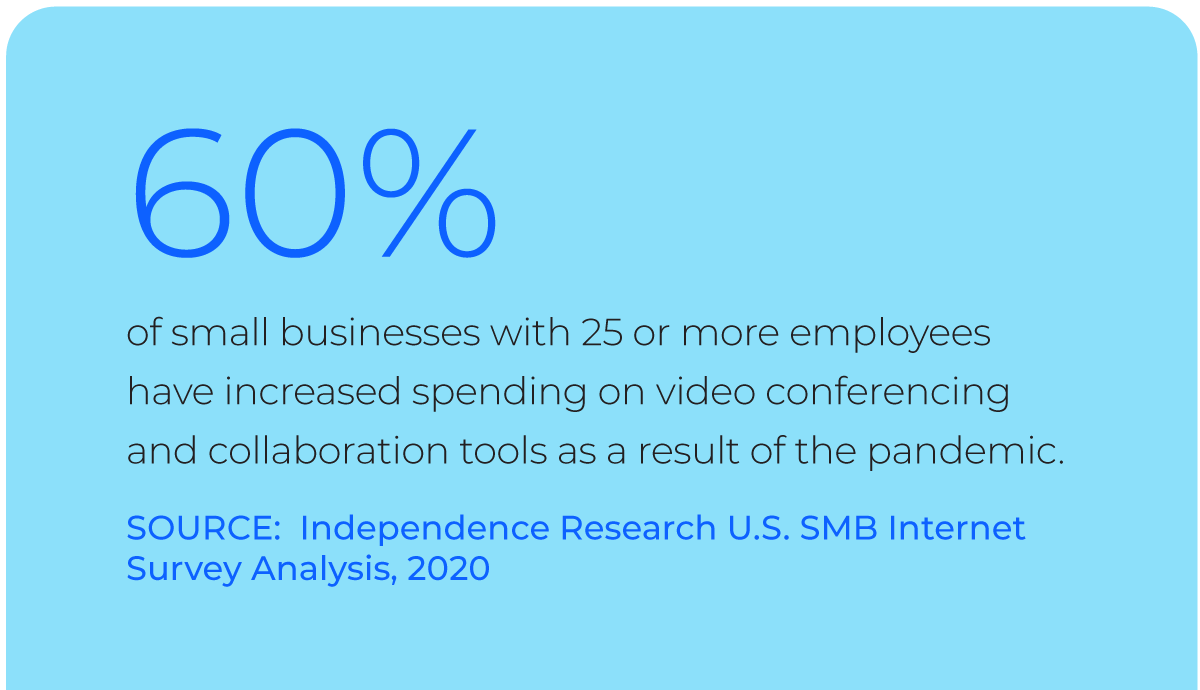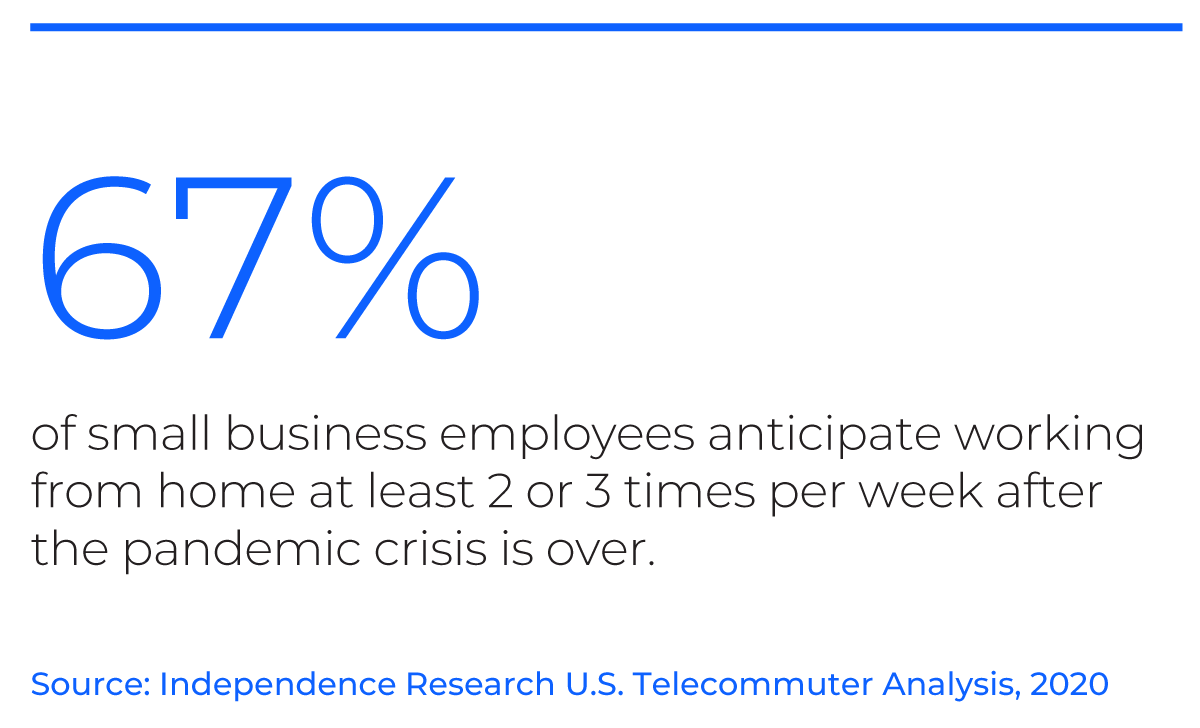The Small Business Guide to Working from Anywhere

Reimagining business starts with reimagining the workplace. The pandemic forced many companies into remote-work arrangements, but it also broke down mobility and geographical barriers for talent acquisition and provided employees with welcome work-life balance benefits. Even as some companies bring employees back into offices and on site, remote work is expected to continue at higher levels than before the pandemic, and new hybrid environments will allow employees to work from the office part-time, and from anywhere else for the remainder. This guide can help you support an environment that allows your team to truly work from anywhere and equip remote employees for success through equipment, technology, and management.
Configure your network
![]()
Assess physical equipment
First, review your physical network configuration. If you haven’t been in the space in a while, you’ll need to check wiring and cabling, firewalls, switches, and access points. Change batteries, clean network closets, and dust off server racks. Note any equipment that isn’t working properly and slate it for replacement at the earliest opportunity.
![]()
Accelerate the shift to cloud
Companies of all sizes are adjusting their networks to support a work-from-anywhere reality by moving data and applications to the cloud. Increasing reliance on cloud, while enabling mobility on a new scale, can also dial up bandwidth requirements.
![]()
Evaluate bandwidth needs
Whether in the office or working remotely, employees need speed. Evaluate what your work model will look like — in person, remote, or hybrid — and select the speeds you need based on historical usage and expectations. Consider purchasing dedicated business Internet for employees you expect to remain fully remote.
![]()
Enable network monitoring
Network monitoring tools can help you evaluate data usage and system performance, and send system notifications. In a hybrid working environment, however, these tools can also keep you apprised of who is at the office and logged onto the network versus who is at home.
![]()
Back it up
If the power goes out at your business location, you can’t afford to cut off Internet access to any employees or business processes. An automatic 4G LTE wireless backup that helps maintain connectivity even during power outages can give you peace of mind and allow business to keep running.
Get collaborative and foster engagement
![]()
Unified Communications
Unified Communications tools include capabilities like instant messaging, conferencing, desktop sharing, and audio, web, and video conferencing. Whether together or apart, teams can collaborate seamlessly, often communicating and sharing files and updates on the same platform. Additionally, easy, quick, real-time communication can help foster a close-knit culture, even if team members can’t be together.
![]()
Video-conferencing
Although video conferencing capabilities are included in some Unified Communications platforms, the video communications market has exploded since the beginning of the pandemic, with online video tools surging in popularity.
![]()
Collaborative productivity tools
Solutions like Microsoft Office 365 and the G Suite allow employees to create, share, and collaborate on projects in real time, even enabling multiple users to work on a document simultaneously.
![]()
Project management
While tracking projects in documents and spreadsheets is the norm for many small businesses, it can become onerous and unorganized fast. Especially in remote or hybrid environments, small business owners should consider dedicated tools to help keep workflows organized and efficient and help employees stay informed on progress.
![]()
Regular updates
With employees no longer tied down to the idea of location, it can be easy for far-flung employees to lose a sense of connection to the business and its mission. A newsletter or company bulletin covering goals, updates, and new initiatives can help keep employees connected, as does regular employee recognition for everyday wins.

Stay secure
![]()
User education
Human error is the root cause of many cyber breaches. Keeping employees educated on cyber threats through regularly scheduled training that starts with onboarding can help eliminate one of the biggest variables in your cybersecurity strategy.
![]()
Threat monitoring, firewalls, and anti-virus
Threat monitoring tools can actively intervene to block malicious threats like malware and ransomware on every device connected to your network, while some anti-virus tools detect and block known malicious files on installed devices and firewalls, and allow only authorized traffic using configured controls. A good strategy may include a good mix of all three solutions.
![]()
Password management
From company-owned laptops to employee-owned cell phones, there are a lot of devices connected to your network, and each of them contain pathways into your network through password-protected systems and applications. One weak password can make you vulnerable to a breach. Tap into a password management system that creates and stores strong passwords or require employees to change passwords at regular intervals.
![]()
Patch management and updates
Unpatched vulnerabilities can provide hackers with documented pathways into systems and applications. Enact strong patch management policies, or consider automating software updates.
![]()
VPNs
Virtual Private Networks (VPN) can establish a secure connection between remote workers and your company network and help reduce the risk of security breaches and cyberattacks.

Don't forget about voice and mobile
![]()
Make sure you’re reachable
As some businesses went temporarily offline during the pandemic, they may have disconnected phone service. If your numbers changed since a year ago, update your online information as soon as possible so customers know how to reach you.
![]()
Take your calls with you
Use a cloud-based phone service that allows you and your employees to select where their phone rings, either at the office, a cell phone, or home land line. Additionally, if you begin a call at your desk phone but need to head out before the conversation wraps up, you can seamlessly move the call to your mobile phone.
![]()
Create a virtual switchboard
Present a polished image for those who call your company, even if there’s no one in the office. Automated attendants can provide greetings and information and route calls to the right person, whether at the business or at home.
![]()
Go with a mobile service that’s specifically designed for small businesses
When you’re selecting a vendor for your organization’s mobile plan, put coverage, flexibility, and price first. Ensure that the plan you choose has nationwide 5G, flexible data plans, affordable unlimited data options, and the compatibility you need to use with all of the best phones and tablets.
Codify your remote work policy and think big
Put remote work in your handbook.
Having a written remote work policy gives employees guidance. Factor in considerations for hybrid work environments that allow some employees to be at work in person and others to be logging on from elsewhere.
Keep it a work in progress
The purpose of a remote or hybrid work policy is to set expectations and ensure that employees are supported, but you’re unlikely to write the perfect draft your first time. Collect feedback from employees and fine tune your policy as needed.
Think outside of your neighborhood
The rise of remote work has broken down geographical barriers for job seekers and hiring managers. As you’re looking to fill new positions, don’t just look for candidates local to your office. Through broader recruiting, you can bring in top-tier talent, regardless of location.

The new work dynamic requires evaluating technology for businesses of all sizes to assess if updates are needed. The right network configurations, the right cybersecurity tools, and the right voice technologies are more important now than ever before. Comcast Business has the solutions to help small businesses stay ready for what’s next.
Tips for SMBs adopting a remote-friendly work environment.
Locked Content
Click on the button below to get access
Unlock NowOr sign in to access all content on Comcast Business Community
Learn how Comcast Business can help
keep you ready for what's next.







